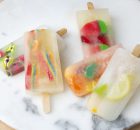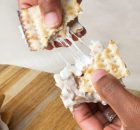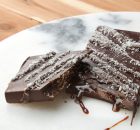How Jelly Beans Are Made
Ever wondered how the yummy Jelly Beans are made? Watch this amazing video and you will go thru the entire process of how jelly beans are made.
Enjoy
Full video transcript
The Jelly Bean is colorful, but its beginnings are a bit of a gray area. It’s believed that this bean’s jelly center dates back to Biblical times in Turkish delight. Many centuries later, the outer shell was added and the jelly bean was on its way to sweet success.
To make jelly beans, liquid sugar is heated in a kettle to about 175 degrees Celsius. Glucose is added, and then starch. An agitating device mixes it all together. Elsewhere in the factory, starch spills out of a drum onto large trays. A leveler moves back and forth to even out the starch. The trays then move forward and a brush knocks of the excess to be recycled. A molding board now presses down into the starch. It makes 756 jelly bean impressions per tray. The impressions in the starch will sever as molds for the jelly bean centers. Nozzles inject the sugar and starch mix cooked in the kettle into the starch molds. This system can make almost a million jelly bean centers every hour.
Next, the conveyor belt system taken the jelly bean centers to the drying room where they stay for 24 hours. This solidifies them and they become chewier. Arms flip the trays of centers and starch and dump them into a drum that will separate them. When the trays flip back they are refilled with starch and the molding process begins again.
Meanwhile, the dried jelly bean centers, now separated from the starch, tumble unto a wire mesh conveyor system. It transports them to a steam belt which dampens them. This readies the for the next step: sugar coating. The jelly bean centers go into a sander drum, which tosses them around while nozzles spray them with sugar.
In another part of the factory, liquid sugar flows out of a kettle into a tub. Blue food coloring is added to the syrup. This mix, called the engrossing syrup, is added, along with some flavoring, to the jelly bean centers as they tumble around in a tilted spinning pan. Sugar is added to the sticky blue mixture. This process is repeated four times in order to build up a coating around the gummy center. The next day, when the beans have hardened, hot syrup is added and the beans are tossed around again. This polishes the jelly beans.
There’s a lot of sweet stuff here: 124,000 Jelly Beans in each pan. A little wax is added: nice, and as the pan spins, the beans rub against each other, distributing the wax. This adds gloss to the polish. Then the pan stops spinning, and the jelly beans air dry for 24 hours to allow the glaze to set.
After three-and-a-half days, this big batch of jelly beans is ready. They move in a multicolored mass along a series of conveyors. They fall into a scale system that divides them into portions. Then a trap door opens, and they drop down a shoot to the packaging department. Once they are in the bag, the jelly beans are ready to sweeten your day.





2 Comments